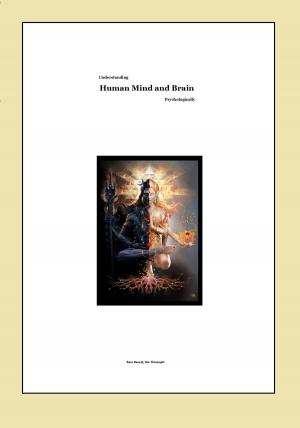| Author: | Ram Bansal | ISBN: | 9781311147370 |
| Publisher: | Ram Bansal | Publication: | March 25, 2015 |
| Imprint: | Smashwords Edition | Language: | English |
| Author: | Ram Bansal |
| ISBN: | 9781311147370 |
| Publisher: | Ram Bansal |
| Publication: | March 25, 2015 |
| Imprint: | Smashwords Edition |
| Language: | English |
Nothing can be more descriptive about the Work than the Table of Contents, provided hereunder. YOU seek, WE have it here.
Preface
Section A : Make-up of a Smart Personality
A1 : Essentials of Smartness or Being Effective, A2 : Working Smartly, A3 : Four Sources of Personality Constitution, A4 : Three Elements of Personality, A5 : Personality Traits for Individual Power, A6 : Leadership Beautitudes in Personality, A7 : Expression and Impression of Personality, A8 : Vaidic View of Personality.
Section B : Management of Life-Smart
B1 : What Controls Life, B2 : What is Management, B3 : Derivations and Divisions of Management Profession, B4 : Six Scales for Quality of Human Life, B5 : Differentiating Smartness, Cleverness and Cunningness, B6 : Education and Training, B7 : Culture and Civilization, B8 : Having own Purpose of Life,
Section C : Arts and Sciences at Work
C1 : What are Arts and Sciences, C2 : Complementary and Supplementary Roles, C3 : Differences of Arts and Sciences, C4 : Basic Sciences controlling Human Skills, C5 :Skills and Professionalism, C6 : Make-up of Work Space, C7 : Making your Work Meaningful and Enjoying it
Section D : Individuals as Social Units
D1 : Self and Society, D2 : What enhances Individual's Social Value, D3 : Cause, Reason and Purpose of a Relationship, D4 : Four levels of Discipline, D5 : Command and Leadership, D6 : Love, Sex and Lust, D7 : Independence, Liberty and Freedom,
Section E : Psychology
E1 : Individual's Conscience and Command of Emotions, E2 : Subjective and Objective Approaches, E3 : Motive and Objective, E4 : Superiority and Inferiority Complexes, E5 : Conduct, Intention and Attitude, E6 : Dedication and Devotion, E7 : Dream, Gamble and Aspiration, E8 : Mind and Brain, E9 : Wisdom and Intellect, E10 : Enjoyment and Addiction, E11 : Pleasure and Happiness
Section F : Written Communications
F1 : Communication and Its Skills, F2 : Communication, Spatial and Temporal, F3 : Author and Writer, F4 : Depiction through Words, F5 : What adds Value to a Written Work, F6 : Vaidic View on Textual Compositions,
Section G : Some Critical Elements of Diction
G1 : Each and Every, G2 : Different and Various, G3 : Recreation and Entertainment, G4 : 'Before', 'in-Front of' and 'Facing', G5 : Fame, Reputation and Popularity, G6 : Strategy, Plan and Scheme, G7 : Appreciation, Praise and Hail, G8 : Article, Essay and Treatise, G9 : Person, People and Humans, G10 : Aim and Target
About the Author
Nothing can be more descriptive about the Work than the Table of Contents, provided hereunder. YOU seek, WE have it here.
Preface
Section A : Make-up of a Smart Personality
A1 : Essentials of Smartness or Being Effective, A2 : Working Smartly, A3 : Four Sources of Personality Constitution, A4 : Three Elements of Personality, A5 : Personality Traits for Individual Power, A6 : Leadership Beautitudes in Personality, A7 : Expression and Impression of Personality, A8 : Vaidic View of Personality.
Section B : Management of Life-Smart
B1 : What Controls Life, B2 : What is Management, B3 : Derivations and Divisions of Management Profession, B4 : Six Scales for Quality of Human Life, B5 : Differentiating Smartness, Cleverness and Cunningness, B6 : Education and Training, B7 : Culture and Civilization, B8 : Having own Purpose of Life,
Section C : Arts and Sciences at Work
C1 : What are Arts and Sciences, C2 : Complementary and Supplementary Roles, C3 : Differences of Arts and Sciences, C4 : Basic Sciences controlling Human Skills, C5 :Skills and Professionalism, C6 : Make-up of Work Space, C7 : Making your Work Meaningful and Enjoying it
Section D : Individuals as Social Units
D1 : Self and Society, D2 : What enhances Individual's Social Value, D3 : Cause, Reason and Purpose of a Relationship, D4 : Four levels of Discipline, D5 : Command and Leadership, D6 : Love, Sex and Lust, D7 : Independence, Liberty and Freedom,
Section E : Psychology
E1 : Individual's Conscience and Command of Emotions, E2 : Subjective and Objective Approaches, E3 : Motive and Objective, E4 : Superiority and Inferiority Complexes, E5 : Conduct, Intention and Attitude, E6 : Dedication and Devotion, E7 : Dream, Gamble and Aspiration, E8 : Mind and Brain, E9 : Wisdom and Intellect, E10 : Enjoyment and Addiction, E11 : Pleasure and Happiness
Section F : Written Communications
F1 : Communication and Its Skills, F2 : Communication, Spatial and Temporal, F3 : Author and Writer, F4 : Depiction through Words, F5 : What adds Value to a Written Work, F6 : Vaidic View on Textual Compositions,
Section G : Some Critical Elements of Diction
G1 : Each and Every, G2 : Different and Various, G3 : Recreation and Entertainment, G4 : 'Before', 'in-Front of' and 'Facing', G5 : Fame, Reputation and Popularity, G6 : Strategy, Plan and Scheme, G7 : Appreciation, Praise and Hail, G8 : Article, Essay and Treatise, G9 : Person, People and Humans, G10 : Aim and Target
About the Author















